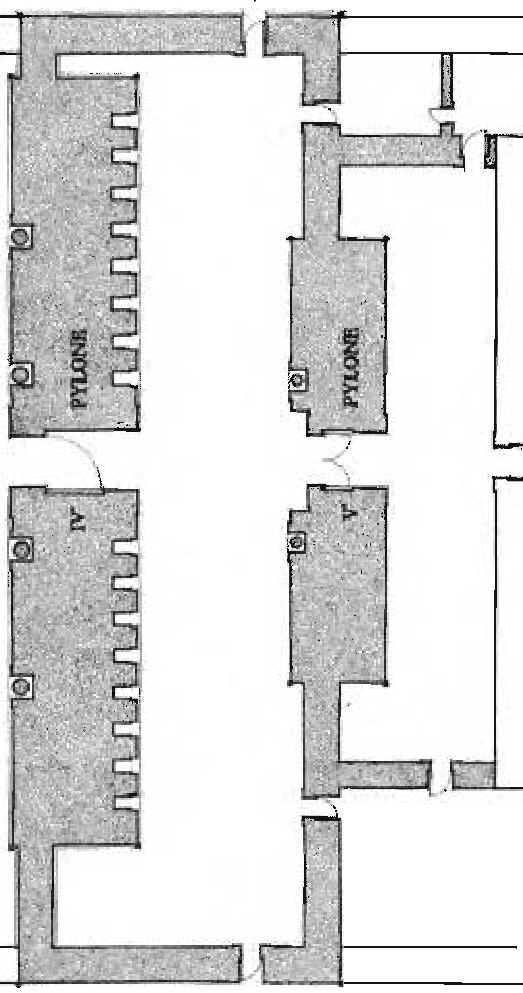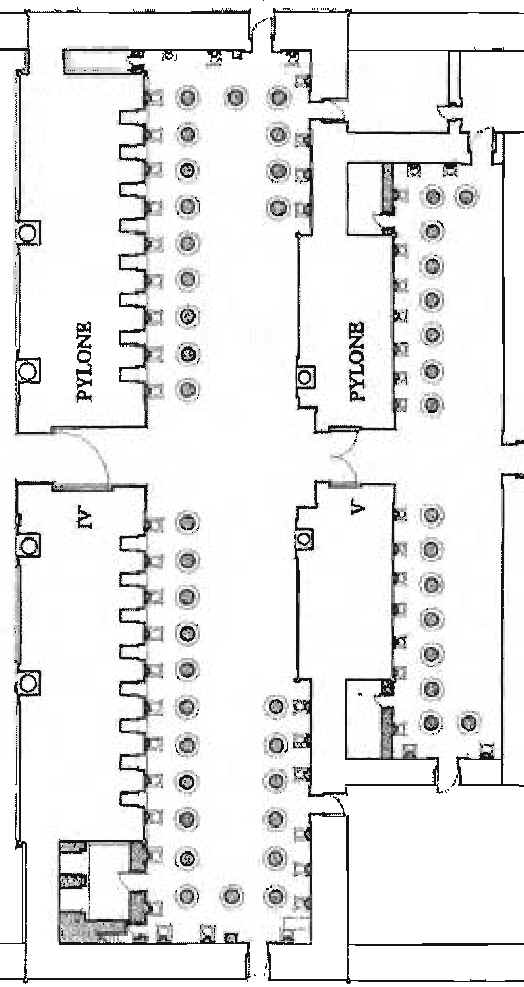|
Karnak-Temple |
last update:
15.03.2013
|
| |
Wadjit-Hall
|
|
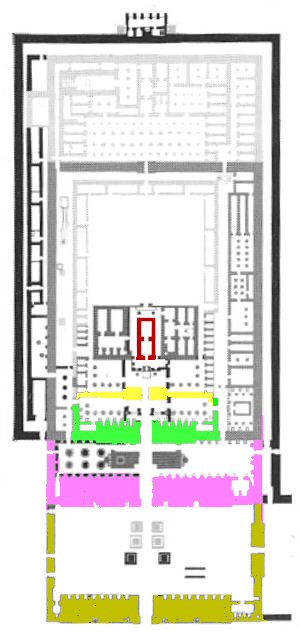
Floor plan of Ip.t-Sw.t ("Elected Place",
modern-day Karnak; plan according to Larché, 2007) at
the times of Hatshepsut and Thutmosis III;
in Red the "Red
Chapel", shown here at the actual discussed location between the
"Chambers" of Hatshepsut;
in Yellow the 6th Pylon, in Green the 5th Pylon, and in Pink the 4th Pylon;
in Brown the "Great Festival Court" of Thutmosis II. |
| The building effort of Thutmosis I, successor of Amenhotep I,
at the temple of Karnak had a great effect on the activities of his successors. |
| Thutmose I erected a monumental gate, the 4th pylon, and at the
same time further to the East a smaller gate, the 5th pylon. The east side of
the 4th pylon impressed by numerous rectangular niches - which unknown until
their recent discovery during excavations (see below) - in which osiride statues
of the King were placed. |
| According to Carlotti and Gabolde Thutmose I had built first an
open court by connecting both pylons on their northern and southern side
respectively by a wall (Carlotti, j.-F., Gabolde, L., Nouvelles données sur la
Quadjyt.) Les Cahiers de Karnak 11, 2003; see the following drawing at the
left). Both walls had a passage to the North or South.
|
| Later, great osiride statue of the king were erected in front
of the wall sections between the niches and sandstone columns were added to the
court at nearly all sides (see follwoing drawing taken from Carlotti, Gabolde,
2003, right) forming a covered peristyle. |
| Development of the der wDjt-hall under Thutmosis I (drawings
of: Carlotti, Gabolde, 2003; 1st construction phase left - Fig. 8A; p. 310; 2nd
construction phase right - Fig. 10a, p. 314). |
| During "rescue work" on the rather destroyed 4. Pylon four of originally 8 niches were discovered in 1999, which
still contained the lower parts of 4 seated Osiride statues made of sandstone. Due to the inscriptions Hatshepsut claimed that these statues were erected by
her on behalf of her father Thutmosis I. Fragments indicated the existence of a relief on the eastern page of the
Pylon - aligned to the inner court and the sanctuary - into which the niches had been integrated.
|
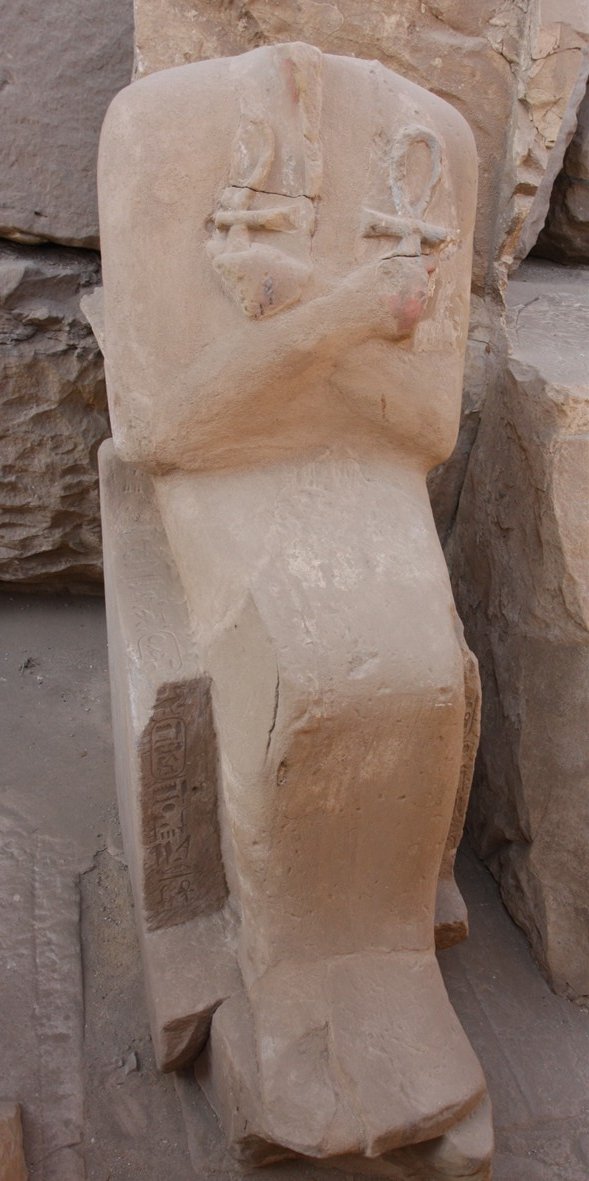
| One of the seated Osiride statues erected by Hatshepsut on behalf of her father Thutmosis I.
The inscription on the right side of the statue shows the cartouche with the throne name of Hatshepsut
on the seat and a cartouche with her birth-name right of the legs.
|
| The niches made of limestone blocks belonged to a previously
undetected eastern front of the pylon and had been established together with the
core structure of the pylon. Numerous limestone fragments of door frames prove
that the niches were decorated in sunk relief. A lintel with a winged sun disk
and a base line including foot over it shows that the eastern front of the
Pylons had been decorated with a large relief.
|
| The hall with papyriform columns was called "wDjt Spst =
venerable pillared hall" in the time of Hatshepsut (Björkman, 1971, p. 61). |
| After her father Hatshepsut rearranged the wadjit-hall: |
| - she removed all columns
erected by her father's and replaced them with 5 wooden papyriform-(wAdj-)columns.
These columns had been erected equidistant from both pylons on the central axis
(in line with her obelisks) of the hall (Carlotti, Gabolde, 2003; see below).
Due to the niche at the south end of the 4th pylon the southern half of the hall
is larger than the northern part. So, in the southern half of three columns were
installed and two in the northern half. Perhaps, the hall had a (wooden)
ceiling, however, the two obelisks prevented a complete roofing. |
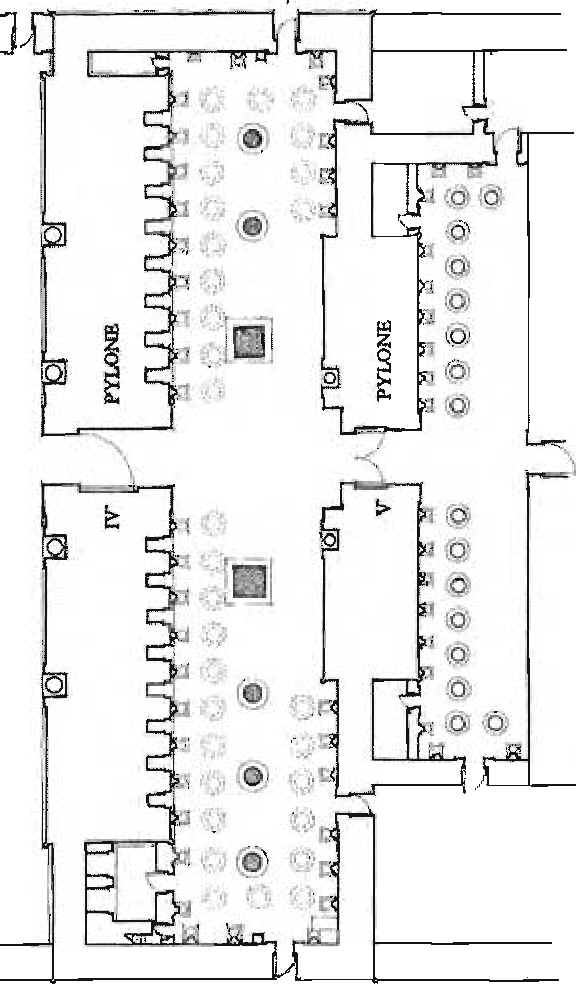
| Floor plan of the Wadjit-hall after the changes made by
Hatshepsut (details from Fig. 10 published by Carlotti, Gabolde, 2003, p. 314) |

| Todays view of the Wadjit-hall from the south. On the left
side the eastern part of the 4th pylon, back on the right side the still
standing obelisk of Hatshepsut. |
|

